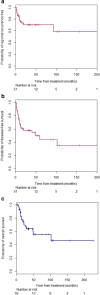The role of salvage surgery with interstitial brachytherapy for the Management of Regionally Recurrent Head and Neck Cancers
- PMID: 31363421
- PMCID: PMC6643309
- DOI: 10.1186/s41199-019-0043-2
The role of salvage surgery with interstitial brachytherapy for the Management of Regionally Recurrent Head and Neck Cancers
Abstract
Background: The optimal treatment for regional lymphatic recurrences from head and neck cancer has not been fully established. In order to explore the therapeutic benefit of surgical resection and adjuvant brachytherapy, the authors reviewed their experience utilizing interstitial brachytherapy (IBT) at the M. D. Anderson Cancer Center.
Methods: A retrospective chart review of the 51 patients who received salvage surgical resection of lymphatic recurrences and adjuvant IBT between 1993 and 2012 at the M. D. Anderson Cancer Center was undertaken. All patients underwent neck dissection with complete resection and intraoperative placement of afterloading brachytherapy catheters. Soft tissue reconstruction was performed as necessary. The technical aspects of IBT were reviewed, and the overall and disease free survival rates and the recurrence rates were determined.
Results: All patients had received external beam radiation (EBRT) as part of their initial treatment to a median dose of 66 Gy; 40 and 68% of the patients also had a neck dissection or chemotherapy, respectively. The cumulative regional recurrence probability is 28 and 38% at 5 years and 10 years. All of the patients underwent salvage neck dissection and IBT, with 81% also undergoing soft tissue reconstruction. The median dose delivered to the tumor bed was 60 Gy over a median duration of 4.5 days. There were 21 early adverse events, 8 of which were severe, and 19 late adverse events, 6 of which were severe. The most common early and late adverse events due to surgery and brachytherapy were dysphagia (7.1%) and true vocal cord paralysis (17.9%), respectively. There were no perioperative deaths or carotid hemorrhages. Nineteen patients developed recurrence including regional recurrence and distinct metastasis. The median time to recurrence is 130 months using Kaplan-Meier product limit method. The 2-year disease-free survival rate was 58%. The 2-year, 5-year, and 10-year overall survival rates were 69, 56, and 46%, respectively.
Conclusions: Regional recurrences in previously irradiated tissues after the definitive treatment of primary head and neck cancers represent a challenging problem. We demonstrated that salvage neck dissection with IBT provided encouraging regional control and survival rates, while maintaining relatively low acute and long-term toxicity rates.
Keywords: Brachytherapy; Neck dissection; Recurrence; Squamous cell carcinoma.
Conflict of interest statement
Competing interestsThe authors declare that they have no competing interests.
Figures



Similar articles
-
The role of interstitial brachytherapy with salvage surgery for the management of recurrent head and neck cancers.Cancer. 2007 May 15;109(10):2052-7. doi: 10.1002/cncr.22648. Cancer. 2007. PMID: 17407106
-
Interstitial low-dose-rate brachytherapy as a salvage treatment for recurrent head-and-neck cancers: long-term results.Int J Radiat Oncol Biol Phys. 2001 Oct 1;51(2):354-62. doi: 10.1016/s0360-3016(01)01637-6. Int J Radiat Oncol Biol Phys. 2001. PMID: 11567809
-
The role of pulsed-dose-rate brachytherapy in previously irradiated head-and-neck cancer.Brachytherapy. 2003;2(3):158-63. doi: 10.1016/S1538-4721(03)00132-6. Brachytherapy. 2003. PMID: 15062138 Clinical Trial.
-
Chemo-reirradiation in persistent/recurrent head and neck cancers.Jpn J Clin Oncol. 2004 Feb;34(2):61-8. doi: 10.1093/jjco/hyh017. Jpn J Clin Oncol. 2004. PMID: 15067097 Review.
-
Patterns of failure following surgical resection for malignant pleural mesothelioma.Thorac Surg Clin. 2004 Nov;14(4):567-73. doi: 10.1016/j.thorsurg.2004.06.006. Thorac Surg Clin. 2004. PMID: 15559064 Review.
Cited by
-
Phase 1/2a, open-label, multicenter study of RM-1929 photoimmunotherapy in patients with locoregional, recurrent head and neck squamous cell carcinoma.Head Neck. 2021 Dec;43(12):3875-3887. doi: 10.1002/hed.26885. Epub 2021 Oct 9. Head Neck. 2021. PMID: 34626024 Free PMC article. Clinical Trial.
-
Near-Infrared Photoimmunotherapy for Oropharyngeal Cancer.Cancers (Basel). 2022 Nov 17;14(22):5662. doi: 10.3390/cancers14225662. Cancers (Basel). 2022. PMID: 36428754 Free PMC article. Review.
-
Interventional radiotherapy (brachytherapy) for re-irradiation of recurrent head and neck malignancies: oncologic outcomes and morbidity.Acta Otorhinolaryngol Ital. 2024 May;44(Suppl. 1):S28-S36. doi: 10.14639/0392-100X-suppl.1-44-2024-N2824. Acta Otorhinolaryngol Ital. 2024. PMID: 38745514 Free PMC article.
-
The evolving landscape of head and neck brachytherapy: A scoping review.J Contemp Brachytherapy. 2024 Jun;16(3):225-231. doi: 10.5114/jcb.2024.140348. Epub 2024 Jun 6. J Contemp Brachytherapy. 2024. PMID: 39629087 Free PMC article.
-
Salvage Perioperative Interstitial High-Dose-Rate Interventional Radiotherapy (Brachytherapy) for Local Recurrences of the Chest Wall Following Mastectomy and Previous External Irradiation.Cancers (Basel). 2023 Jan 18;15(3):614. doi: 10.3390/cancers15030614. Cancers (Basel). 2023. PMID: 36765571 Free PMC article.
References
-
- Mabanta SR, Mendenhall WM, Stringer SP, Cassisi NJ. Salvage treatment for neck recurrence after irradiation alone for head and neck squamous cell carcinoma with clinically positive neck nodes. Head Neck. 1999;21(7):591–594. doi: 10.1002/(SICI)1097-0347(199910)21:7<591::AID-HED1>3.0.CO;2-Y. - DOI - PubMed
-
- National Canceer Institute, National Institutes of Health, US Department of Health and Human Services. Ceommon Terminology Criteria for Adverse Events (CTCAE) Version 4.0. Published May 28, 2009; Revised version 4.03 June 14, 2010 (Vol. Available from: https://evs.nci.nih.gov/ftp1/CTCAE/CTCAE_4.03/CTCAE_4.03_2010-06-14_Quic.... Accessed 20 May 2013).
-
- Li M, Lorenz RR, Khan MJ, Burkey BB, Adelstein DJ, Greskovich JF, Jr, Koyfman SA, Scharpf J. Salvage laryngectomy in patients with recurrent laryngeal cancer in the setting of nonoperative treatment failure. Otolaryngol Head Neck Surg. 2013;149(2):245–251. doi: 10.1177/0194599813486257. - DOI - PubMed
Grants and funding
LinkOut - more resources
Full Text Sources
